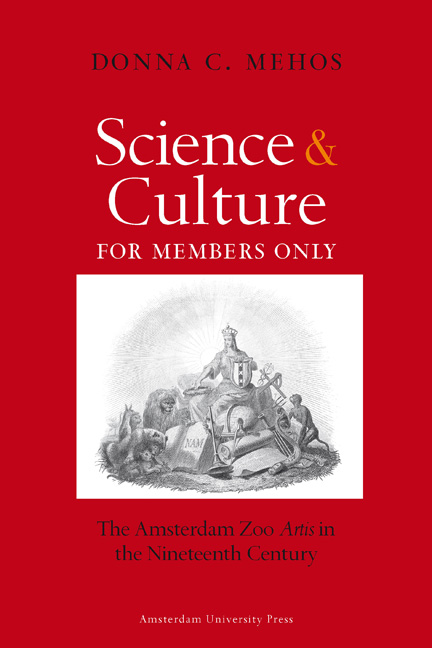Book contents
- Frontmatter
- Dedication
- Contents
- Acknowledgments
- Introduction The Nation and Nature in Middle-Class Culture
- Chapter 1 Structuring a New Generation’s Scientific Society
- Chapter 2 Private Science and the Public Interest
- Chapter 3 Internationalizing Nationalist Science
- Chapter 4 Science Joins Cultural Life
- Conclusion Science, Colonial Expansion, and National Identity
- Appendix: Members of the Artis Board of Directors, 1838-1870
- Notes
- List of Illustrations and Color Plates
- Bibliography
- Index
- Plate Section
Chapter 4 - Science Joins Cultural Life
Published online by Cambridge University Press: 20 January 2021
- Frontmatter
- Dedication
- Contents
- Acknowledgments
- Introduction The Nation and Nature in Middle-Class Culture
- Chapter 1 Structuring a New Generation’s Scientific Society
- Chapter 2 Private Science and the Public Interest
- Chapter 3 Internationalizing Nationalist Science
- Chapter 4 Science Joins Cultural Life
- Conclusion Science, Colonial Expansion, and National Identity
- Appendix: Members of the Artis Board of Directors, 1838-1870
- Notes
- List of Illustrations and Color Plates
- Bibliography
- Index
- Plate Section
Summary
Here we see the attributes of Science and Art displayed.
On one side the animals, the living works of God almighty.
Thanks to art and science, from which shipbuilding arose,
Almost every kind of animal towards Amsterdam flows.
The rising sun conveys happiness, warmth and light:
It is harmony pure, that radiates peace, so bright.
On the left, Neptune's trident, depicting travel over the seas;
Near it, the symbol of commerce from the Greeks’ Hermes.
The anchor of hope gives strength to our stride;
So, in our favorite garden we forget troubled times.
The city's patroness views her institution with a proud gaze,
Bringing to the mighty Amsterdam, both honor and praise.
Opened at her foot is the book of our zoological garden;
Because she worships nature, praising without pardon
Its Artistic value, she offers the laurel crown to our Society.
And the future? Grow in splendor on the IJ!
(T.J. Kerkhoven, Artis Jaarboekje 1852)Introduction
This explicit poetic description of Artis by a board member leaves little to the imagination. Science, art, animals, shipbuilding, navigation, and commerce join together at the zoological garden that honors, and is honored by, the patroness of Amsterdam (Illustration 8). The poem, in essence, pays tribute to the enterprising Dutch who shared their personal wealth when supporting the Amsterdam zoological institution. Artis, in turn, became a cultural center for the city, and a source of civic pride.
The Dutch defined a new national cultural identity after years of French rule that ended in 1813 and the economic recovery that was a result of the reconstructed colonial trade. In the first half of the nineteenth century, the new elite that earned fortunes in commerce also developed a sense of civic responsibility and felt compelled to breathe vitality into Dutch culture that, during this period, had been characterized as “lifeless.” Like their counterparts across Europe, the Amsterdam burghers aspired to create new significant cultural institutions and to reshape Amsterdam's cultural life. Artis is the foremost example of their success in the middle decades of the nine-teenth century. It generated more enthusiasm and capital than, for example, the modest national art museum, the Rijksmuseum, that housed numerous Dutch Masters.
- Type
- Chapter
- Information
- Science and Culture for Members OnlyThe Amsterdam Zoo Artis in the Nineteenth Century, pp. 91 - 124Publisher: Amsterdam University PressPrint publication year: 2006



